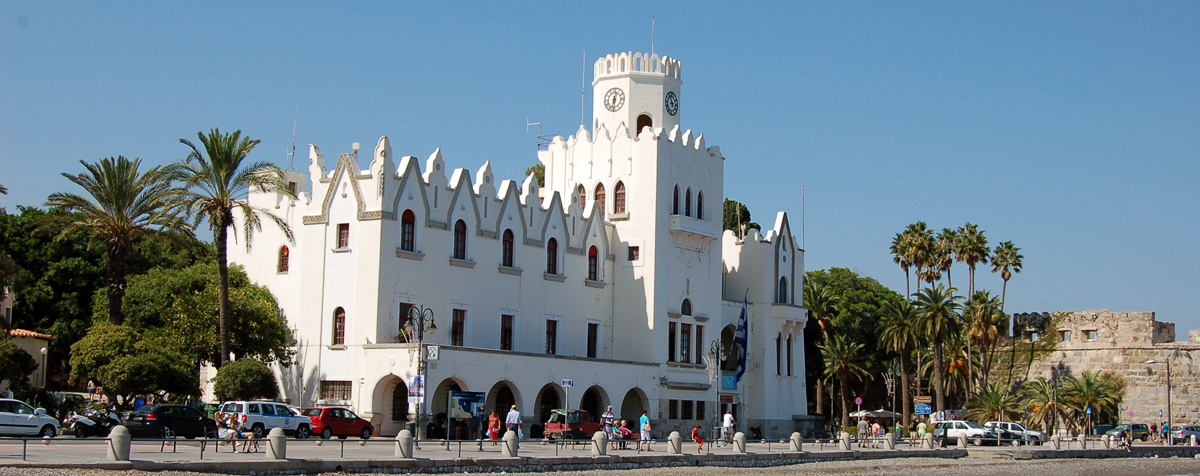
Kos is the island of the father of medicine Ippokrátis (mid 5th – mid 4th century BC). The island’s name has been Kós since antiquity. Findings in the Áspri Pétra cave (south of Kéfalos) prove inhabitance from the Early Neolithic Age (4000BC). Minoans from Crete came around the 15th century BC and colonised the island. Afterwards came the Achaeans from Epídavros and finally Dorians.
Tradition has it that the demi-god Hercules arrived on the island and married the princess of Kós Chalkiópi, who gave birth to Thessalós (later king of Nísyros, Kálymnos and Léros). Thessalós’ sons Antíphos and Pheídippos took part in the Trojan war (12th century BC) as leaders with 30 ships (from kós, Léros, Kálymnos, Nísyros and Kásos). In the 7th century BC, the island forged the “Dorikí Exápoli” along with the towns of Ialyssós, Kámeiros and Líndos of Ródos and Knídos and Alikarnassós of the opposite Asia Minor, which was also a political alliance.
The first capital of the island was Astypálaia, which was completely destroyed by earthquake at the end of the 5th century BC. This town was a little further south than today’s village of Kéfalos, and had its harbour in today’s Kamári. The town of Kós and later capital of the island, up until today, came about from a union of smaller settlements, in the mid 4th century.
Towards the end of 6th century BC the island was captured by Persians, which is why 5 of Kós’ ships also took part in the Sea Battle of Salamína (480BC). Kós was later a member of the Athenian Alliance.
The great doctor of antiquity, Ippokrátis, was born in Astypálaia of Kós during this age in 460BC, who was the first to categorise methods of diagnosis and recommend therapies to his patients. For this reason he is known world-wide as the “father of medicine”. Since his age started the supplantation of the various quacks who practised medicine. This great doctor was above money and modest and taught many future doctors. At the end of his life, he lived in Lárisa in Thessalía, where he died at the age of 104. His grave survived up until the recent past, that is up until the beginning of the 19th century, and the monument that was inscribed with the name of the great doctor from Kós, stood in the house of the Turkish bey (witness accounts).
In the 4th century BC the island thrived. Its inhabitants reached 160,000 in number. At the end of the century, the island was allied with Makedonía. Afterwards, came the Roman rule (when many treasures were removed and taken to Italy) and from the 4th century AD, the island belonged to the Byzantine Empire. From the 5th to the 12th centuries, the island suffered many pillaging raids by the Vandal, Visigoths, Slavs, Arabs, Saracens, Norman and Crusaders and finally ended up in Frankish hands (after the fall of Constantinópolis in 1204).
From the 14th century AD, the island belonged to the St John’s Knights from Rhodes for two centuries. At the beginning of the 16th century, the knights made a deal with the Turks and handed over the island, taking off towards the West together with riches. The island then suffered expulsions, mass-kidnapping of children, carnage and unrelentless demands from the Turks. Among those martyred was Ioánnis Náfkliros who was burned alive for not renouncing his faith and becoming a Muslim and the 92 elders of the island, who were hung from Ippokrátis’ plane tree, as the Turks learned that the people had provided help to the other Greek during the liberational wars. The Italians captured Kós, as they did the other Dodekánisa, in the beginning of the 20th century. They closed the Greek schools and opened Italian schools in their place, forbade anybody to become an Orthodox priest and promoted Catholicism, but they also fixed the town plan and built roads. The island was finally reunited with Mother Greece in 1948.

Sightseeing: The town is full of monuments marking all of its ages, such as the eternal plane tree of Ippokrátis (trunk perimetre 16m, the father of medicine taught under its shade), the ruins of the ancient town, the Roman house, the house of Evrópi, the Castle of Knights, the Mosque, the numerous churches, the Italian buildings (from the time of Italian rule at the beginning of the 20th century) and many others. Most of these can be visited with the municipal train, which goes around the town and simultaneously gives a tour guide to its passengers. The towns road’s are comfortable, with the shade from the trees and its flowers giving a pleasant look. The bicycle is the most usual mode of transport, as the town is flat, and indeed there are special bicycle paths in some parts. Kos is very beautiful. It manages to keep its colour and a heavy tourist trade at the same time.
Asklipieío (22420 28763), a stirring monument, which was founded in the 4th century BC and was added to up until the 2nd century BC. The largest theraputic centre of Greece stood here as well as the School of Ippokrátis.
Thérmes: Therapeutic springs for rheumatism, arthritis and gynaecological complaints.
Zía: Settlement of Asféndios, built on a site of great beauty, as noted in the tourist brochures. Onw could also mention gastranomic delights. Anyhow, the whole area of Asféndios has been characterised as having great beauty and is now and area of conservation.
Flavours: In Kós you will find Greek and International cuisine, especially in the more touristic areas. You should look for authentic traditional tastes in the villages. The red cheese flavoured with wine, is a delicious snack to go with wine. The unbottled wine is very good.





